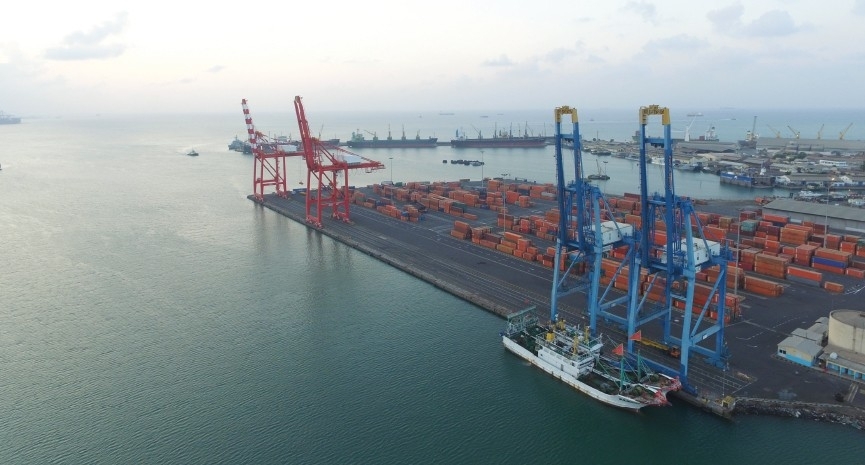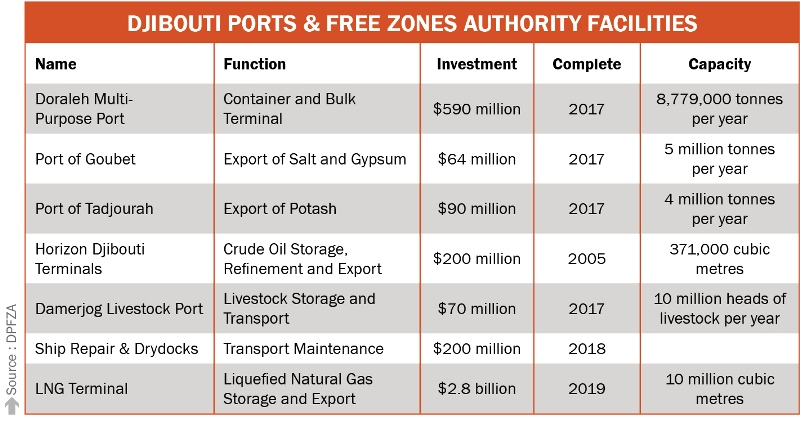FROM MAGAZINE: Djibouti marks strong impression on world’s maritime map
Over the last few years, Djibouti has dramatically expanded its ability to serve as a pitstop for cargo sailing from and to the Far East as well as a multi-modal logistics hub for East African countries.

Over the last few years, Djibouti has dramatically expanded its ability to serve as a pitstop for cargo sailing from and to the Far East as well as a multi-modal logistics hub for East African countries. The country is constantly investing on its ambitious maritime infrastructure in a bid to attract shipping lines to maximise its capacity utilisation,
Shreya Bhattacharya reports.
Djibouti’s geostrategic location in the world’s maritime map is hard to ignore. Sitting on two of the biggest maritime trade routes in the world, from where at least 30 percent of all shipping in the world passes, Djibouti stands a chance to capitalise on the immense opportunities laid out for it to bring fortune to its economy. The Port of Djibouti, which came into existence as a result of the search launched by Ethiopia for a maritime outlet, today serves as a key refueling and transshipment centre, as well as a principal maritime outlet for imports and exports from the surrounding landlocked African hinterland.
Over the years, Port of Djibouti has seen the shipping trade through this maritime route multiplying manifolds and felt the need to expand its infrastructure, in order to cater to the growing requirement. At least 30,000 ships transit through this port in an year, where goods from Asia represent 59 percent, with 21 percent coming from Europe and 16 percent from elsewhere in Africa. In 2015, overall traffic to Djibouti increased by nearly 20 percent, reaching approximately 5.7 million tonnes.
Also, in a bid to expand Djibouti’s ability to serve as a platform and trade hub for East African countries and African countries beyond the region, the Djibouti Ports and Free Zones Authority (DPFZA) is leading a $15 billion infrastructure programme.
“Our major challenge has been to anticipate the fast-growing demand in the region. When we design a new port, a new railway or a new free trade zone, we have to anticipate four or five decades of growth. Africa is expected to reach 2.5 billion people by 2050; this will represent a quarter of the world population. In terms of economic growth, East Africa is the fastest growing region in Africa, and one of the fastest growing regions in the world. This means that trade is moving at a fast pace, and the demand for infrastructure is constantly growing. We are determined to keep pace with our continent’s tremendous potential,” says Aboubaker Omar Hadi, Chairman, DPFZA.
The country saw inauguration of the first three of the four new ports in 2017, which were being constructed to make the economy more export oriented.
Build on an investment of more than $590 million, financed by DPFZA and China Merchant Holdings (CMHC), the Doraleh Multipurpose Port expands across 690 hectares and has a bulk, break bulk, RO-RO and container terminal. The facility can handle 8,779,000 tonnes per year at full capacity, which makes it as one of the biggest ports in East Africa.
Port of Goubet will allow the export of salt and gypsum deposits of Lake Assal. Djibouti, which has the largest salt deposit in the world, plans to export more than 5 million tonnes of salt across the world annually through this port in the near future. The mineral port will also benefit regional economic powerhouse, Ethiopia, as it is expected to facilitate the export of minerals from the landlocked neighbour.
The Port of Tadjourah aims to strengthen Djibouti’s position as the gateway to Common Market for Eastern and Southern Africa (COMESA) member countries. It is the key component of a major infrastructure project, which includes the construction of the North Tadjourah-Balho corridor road, and the construction of the new north corridor railway.

“The demand for ports infrastructure is huge and constantly growing. Therefore, it is our responsibility to develop our port capacity, and more generally our infrastructure offer. For that reason, the three ports we have inaugurated will have a total capacity of 18 million tonnes. DMP is already working at full capacity, which demonstrates that our ambitious development plan is already meeting a genuine need in the region,” informs Omar Hadi.
Growing competition in the region
As other important ports located in the Horn of Africa gear up to refurbish themselves, a substantial amount of business is set to get divided within the region. In May, Dubai-based DP World was awarded the concession to manage and expand the Port of Berbera for 30 years, a project valued at about $442 million. The deal could restore Berbera’s reputation as a major trading hub, creating competition for Djibouti, which has come to dominate trade in the region during the last decade.
In order to stay ahead in business in the region, Djibouti is constantly investing on improving efficiency within its ports. “Djibouti is working on improving the dwell time, as we know that efficiency is key for a port to be successful. The recent ports we have launched are state-of-the-art facilities, equipped with the most modern logistics set-up,” says Omar Hadi. The port currently takes 15 days in import, 5 days in export and 3 days in transshipment processing, he informs.
“It should be noted that the dwell time - per definition, being the time between cargo discharge from ship and cargo gate out from terminal - is no longer considered as a reliable performance indicator. The importer/consignee is the one to process the clearance to gate out the cargo. Understandably, the dwell time is certainly influenced by the speech of the importer/consignee processes to clear cargo. For instance the ports of Djibouti introduced online systems so that cargo could be cleared the same day it has been discharged. Today, dwell times in Djibouti ports are affected by the fact that importer/consignee takes days, or even weeks, to come and claim the cargo. The result is the stockage area becomes full, and the port needs to keep the cargo until it is claimed. DPFZA has been working closely with the different stakeholders of the ports to reduce this, and we've already noticed improvements,” says the DPFZA chairman in defence.
Future projects
Djibouti is currently working on two new ports. The construction of Damerjog Port, a multipurpose port with a special focus on livestock, will be completed in 2018.
The LNG Terminal, which will focus on liquefied natural gas storage and export, will be completed in 2019. With a capacity of 10 million cubic metres, this port will be beneficial for the whole region, as it will ship the fuel to the world’s largest energy consumer, China.
Partnership with China- a win-win situation or growing dependency?
Djibouti has been hooked up with China on several infrastructure projects. The partnership was also instrumental in the delivery of the new electric railway connecting Ethiopia and Djibouti. Implemented together with China Railway Group Limited and China Civil Engineering Construction Corporation, the railway has been essential in strengthening trade routes that integrate Africa into the Belt and Road initiative. China is also financing as well as working on major projects, including the Djibouti International Free Trade Zone (DIFTZ), and the Doraleh Multipurpose Port in a bid to establish the tiny country as a critical junction on the Maritime Silk Road.
While the DPFZA gives a lot of weightage to China’s expertise, many have raised concern due to the country’s growing dependency on Chinese capital. The country needs to strike a balance between success and financial returns.


